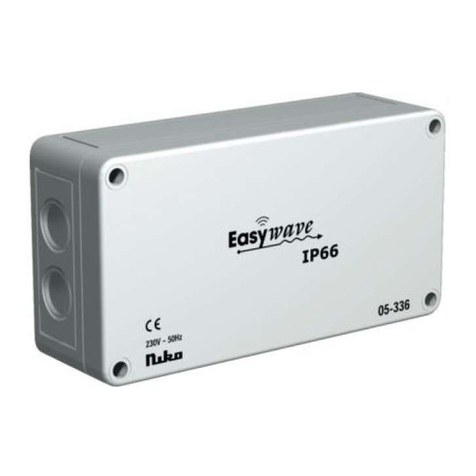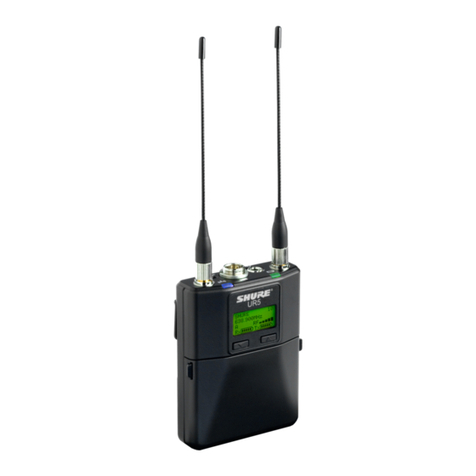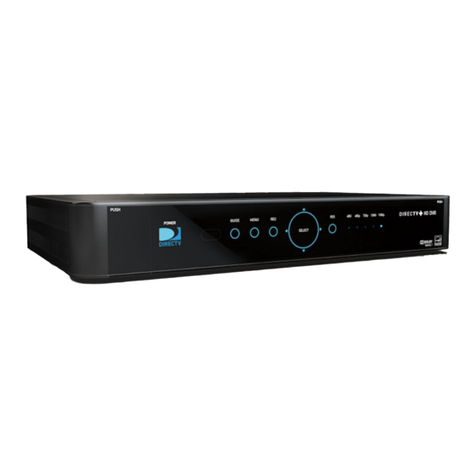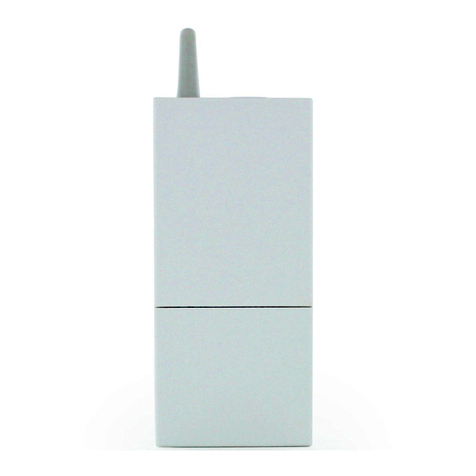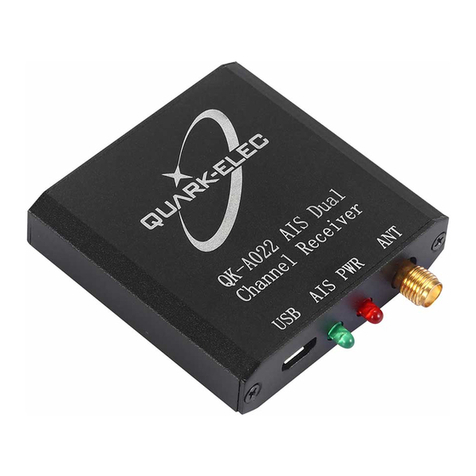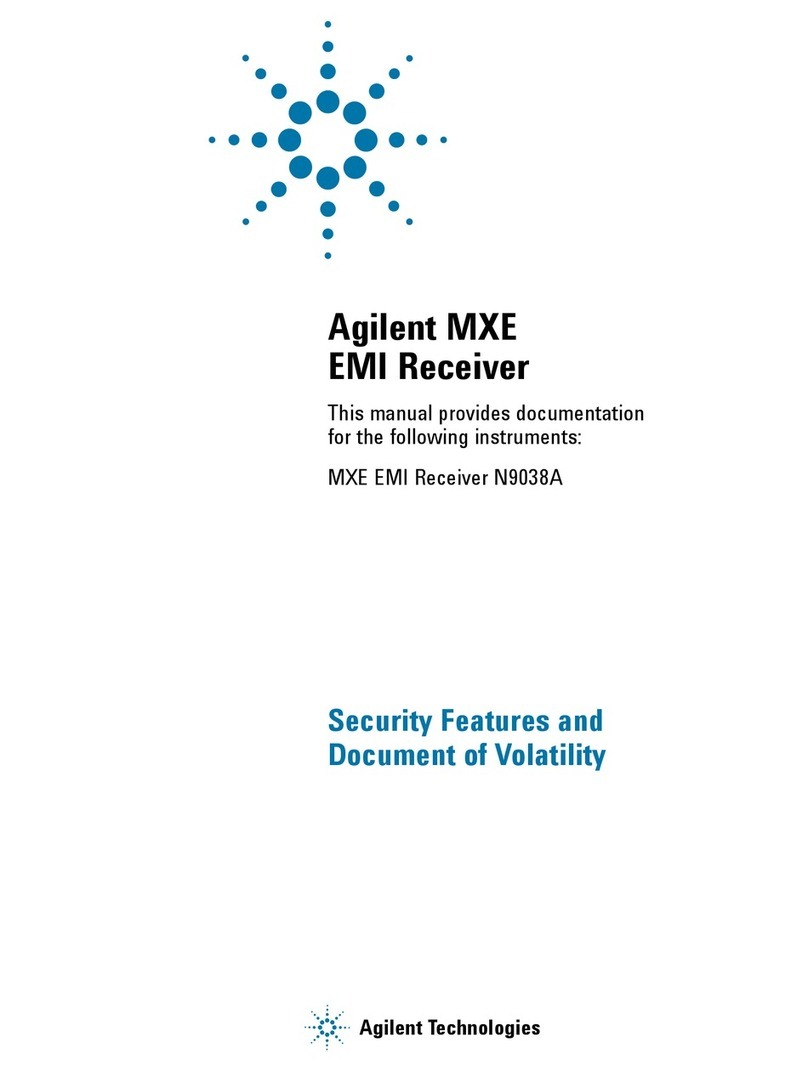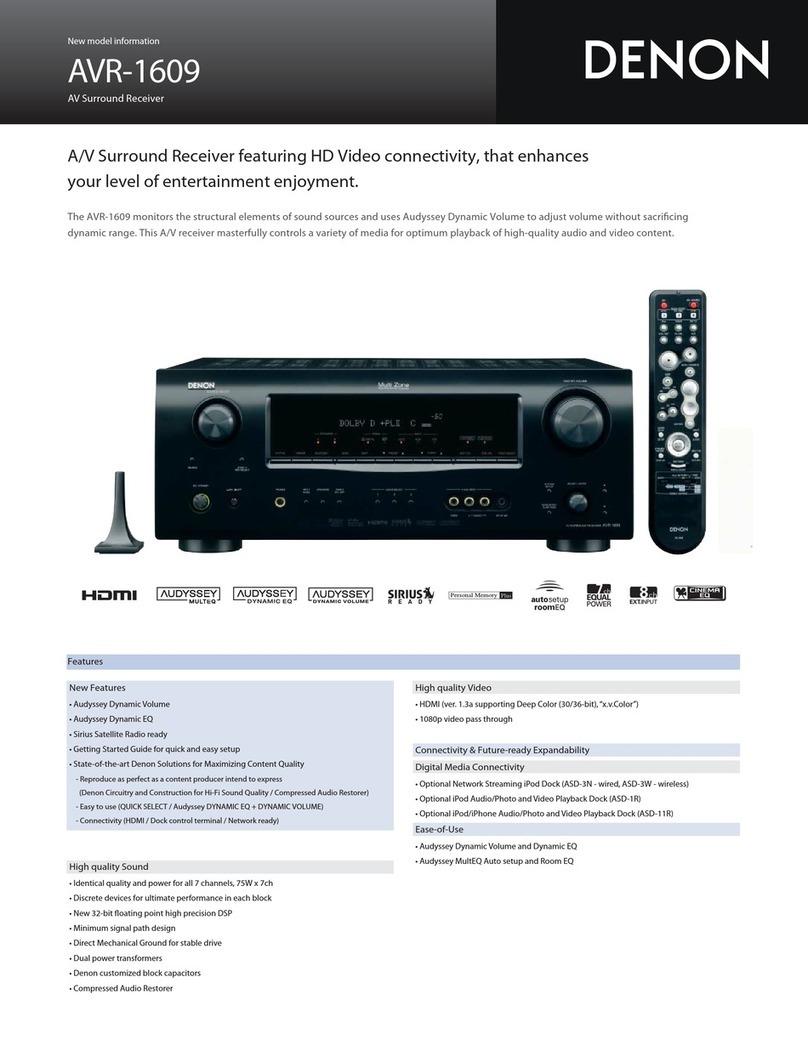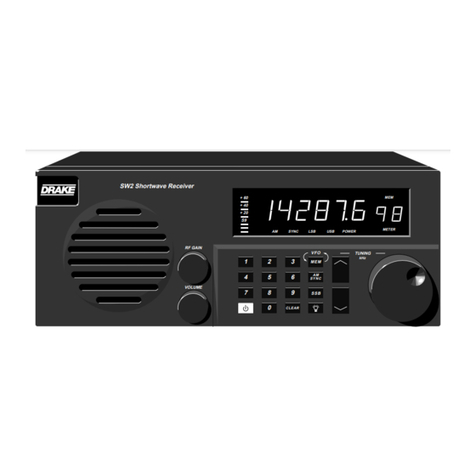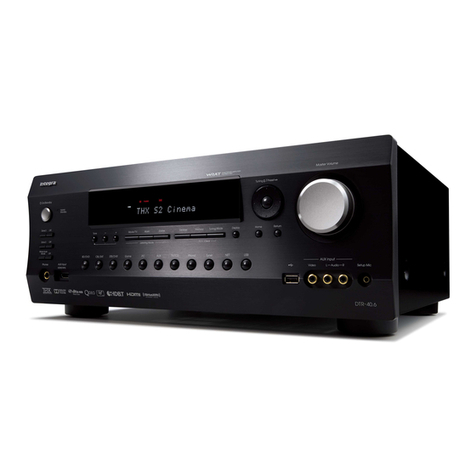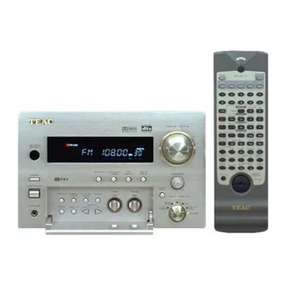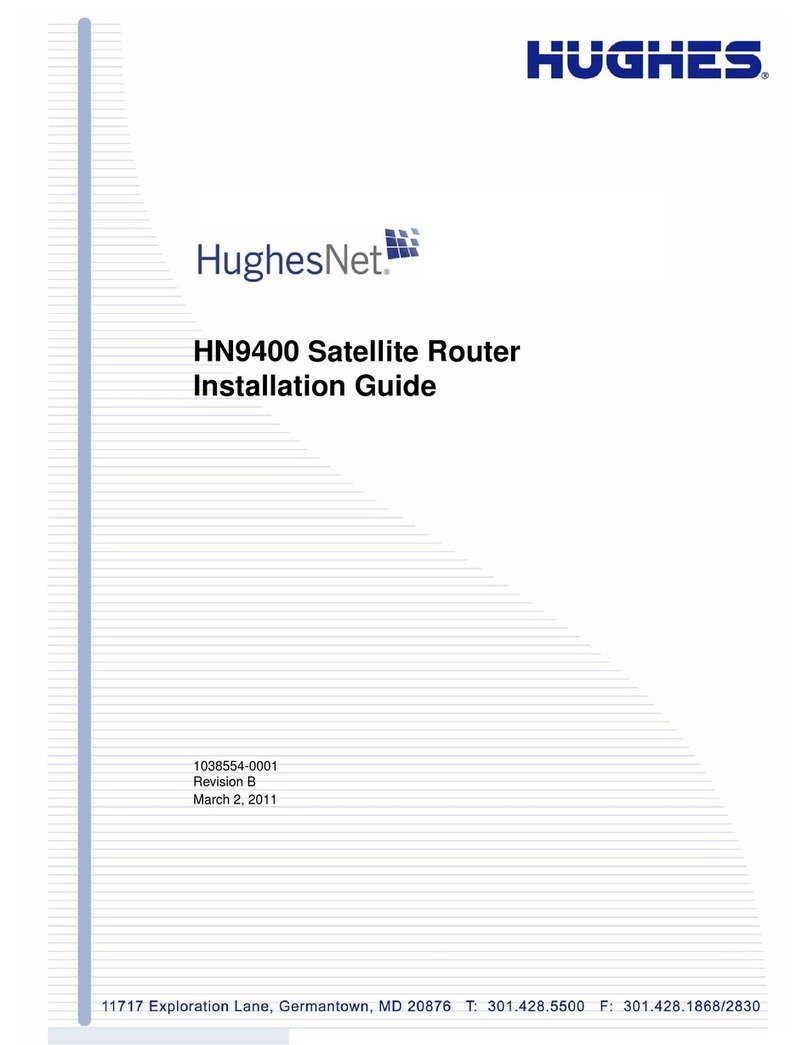GEORGE K9GDT User manual

K9GDTK9GDT
40m40m CW/SSBCW/SSB
ReceiverReceiver
by George!

Contents
Introduction
1-1 Description of Receiver ....................................................................................................................
1-2 Specifications ...................................................................................................................................
Circuit Description
2-1 Bandpass Filter ................................................................................................................................
2-2 Mixer - Post Mixer Amplifier ...........................................................................................................
2-3 Crystal Filter - IF Amplifier - AGC Module .....................................................................................
2-4 400Hz Noise Filter/ Product Detector Module ..................................................................................
2-5 Audio Processing Board - AF Power Amplifier ...............................................................................
2-6 VFO .................................................................................................................................................
2-7 LO - Passband Generator Module .....................................................................................................
2-8 BFO Generator ..................................................................................................................................
2-9 Display Module ................................................................................................................................
2-10 Power Supply ...................................................................................................................................
Alignment and Calibration
3-1 Required Test Equipment ..................................................................................................................
3-2 VFO ..................................................................................................................................................
3-3 LO - Passband Generator Module ......................................................................................................
3-4 BFO Generator ................................................................................................................................
3-5 Bandpass Filter ...............................................................................................................................
3-6 Mixer - Post Mixer Amplifier ..........................................................................................................
3-7 Crystal Filter - IF Amplifier - AGC Module ....................................................................................
3-8 Audio Processing Board .................................................................................................................
3-9 Display Module ...............................................................................................................................
Illustrations
Figure 1-1 The K9GDT 40m Receiver .....................................................................................................
Figure 2-1 Receiver Block Diagram ........................................................................................................
Figure 2-2 Front Panel Controls ..............................................................................................................
Figure 2-3 Rear Panel Controls and Connections .....................................................................................
Figure 2-4 Interior Views - Module Locations ........................................................................................
Figure 3-1 LO - Passband Generator Module ...........................................................................................
Figure 3-2 BFO Generator .....................................................................................................................
Figure 3-3 Crystal Filter - IF Amplifier - AGC Module .........................................................................
Figure 3-4 Audio Processing Board .......................................................................................................
Figure 3-5 Display Module ....................................................................................................................
ii
1
2
3
3
4
5
5
6
6
6
6
7
9
9
9
10
10
10
11
12
13
1
3
7
7
8
9
10
11
12
13

Introduction
1-1 Description
The K9GDT 40m receiver is a solid state receiver that
offers a very high level of performance for the 40m
Amateur Radio Band. It has excellent sensitivity,
selectivity, and dynamic range. In addition, the
receiver features a digital frequency readout and
interference reduction circuitry.
The front panel layout is optimized for ease-of-use.
Large controls are ergonomically placed in functional
groupings, with frequently used controls positioned
close to the large, weighted main tuning knob.
Adoubly balanced switching-mode mixer is used as
the front-end mixer in a single conversion scheme.
This technique ensures optimum front-end overload
and IMD performance.
The front panel SELECTIVITY switch allows the
operator to select either a 2.1KHz or 400Hz IF
bandwidth. Each bandwidth is provided by inserting
the appropriate eight-pole crystal filter between the
post-mixer amplifier and the IF amplifier. When the
400Hz position is selected, a second 400Hz filter is
inserted before the product detector to remove
broadband noise produced by the IF amplifier.
The PASSBAND tuning control is an operating aid
useful in reducing or eliminating interfering signals.
It electronically positions crystal filter’s response
curve around the displayed frequency. This enables
the operator to shift that response such that a nearby
interfering signal is positioned down on the filter’s
skirt.
The NOTCH TUNE control varies the center
frequency of the AF notch filter. This feature is useful
for eliminating interference from CW carriers and is
especially useful in the upper portion of the band,
which is shared with foreign broadcast services.
The receiver features a “tuned” audio section capable
of delivering 3.5 watts to an eight ohm speaker.
Frequency response is tailored by active, passive, and
switched capacitor filtering.
Other features include external mute control, a
transmit monitor mode, selectable AGC time
constants, an AGC defeat mode, a CW keyer sidetone
input, and a convenient tilt bail located on the
receiver’s bottom panel.
Page 1
Figure 1-1 K9GDT 40m Receiver

1-2 Specifications
18½ lb.
Weight
> 60 dB
Image Rejection
5¼ in. high
17 in. wide
10¼ in. deep
Dimensions
> 100 dB
IF Rejection
102-132 VAC, 50-60Hz
30 Watts max.
Power Requirements
3.395MHz
IF Frequency
3.5 Watts RMS @ less
than 5% THD into 8 Ω
Audio Output
None
Internally Generated
Spurs
The receiver’s display
frequency ±4KHz
Passband Tuning Range
+7 dBm **
Intercept Point
Notch Depth > 40 dB
400Hz -3KHz
Notch
Less than 6 dB output
variation for a 100 dB
input signal change,
referenced to AGC
threshold. (< 1µV )
Dynamic Characteristics:
Attack time - 1 ms.
Decay times - 20 ms.
500 ms.
5 seconds
AGC
< 1KHz during first 60
minutes after power-up
< 100Hz /hr thereafter
Frequency Stability
2.1KHz @ −6 dB
3.9KHz @ −60 dB *
400Hz @ −6 dB
1.0KHz @ −60 dB *
Selectivity
10ppm ±100Hz
Frequency Readout
Accuracy
2.1KHz - Less than 0.4 µV
for 10 dB S+N
N
400Hz - Less than 0.15 µV
for 10 dB S+N
N
Sensitivity
< 65 dB
Spurious Response
40m Amateur Radio Band
Frequency Coverage
Introduction
Page 2
* These values are approximate. Accurate measurements were impeded by the test generator’s noise floor.
** Suitable test equipment was unavailable to measure this parameter. So Hayward’s rule-of-thumb was used to
“guesstimate” it’s value.

Circuit Description
2-1 Bandpass Filter Module
The Bandpass Filter module has an input and output
impedance of 50Ωand consists of two major sections:
a dual resonator parallel tuned bandpass filter and a
seven element low pass filter for additional
attenuation of image frequencies from 13.79 through
14.09MHz. The module’s insertion loss is under 1dB.
2-2 Mixer - Post Mixer Amplifier
Introduction
Page 3
Figure 2-1 Receiver Block Diagram
The mixer stage is a doubly-balanced diode-ring
device made by Mini-Circuits Laboratories, model
SBL-1. The 10.395-10.695MHz local oscillator drive
level is +7dBm.
A 6 dB pad is placed between the mixer output and
the post-mixer amplifier, which is a low noise, high
dynamic range broadband bipolar amplifier with a
50Ωinput impedance. This arrangement assures a
proper non-reactive termination at the mixer’s IF port
for all frequencies present, thereby preserving it’s
IMD performance and eliminating the requirement for
a diplexer. Because a very low noise figure is
normally not necessary around 7MHz,the pad’s 6 dB
insertion loss is tolerable.
The post-mixer amplifier has a gain of 20 dB using an
NTE278 transistor, which has an fTof 1.2 GHz and a
noise figure of about 4 dB. This device is heat sunk
and biased to a standing current of 70 ma. The
amplifier’s output is matched to the 2 kΩinput
impedance of the crystal filter which follows.
Display Mixer - 40673
Frequency
Counter
7216C
7258.0
L.O.
BFO
K9GDT 40m CW/SSB Receiver
by George!
A.F.
Amplifier
3.5W 8
Ω
7-7.3 MHz First Mixer
SBL-1
Low Noise
Post Mixer
Amplifier
2.1 kHz
400Hz
3.395 MHz
8 pole
Crystal Filters 500Hz
Filter
Gain EQ
MC1350
I.F.
Amplifier
AGC
400Hz
-6db
Pad
Post I.F.
400Hz Filter Product
Detector
MC1496 Tuneable AF
Notch
400-3000 Hz
Switched
Capacitor
L. P. Filter
3.0 kHz
10.395-10.695 MHz
+7dbm
LO Pre-mix
SBL-1
4395 ±4 KHz
AC
6-6.3 MHz
Main Tuning BFO
3395 ±4 KHz
AGC
5.2v no signal
5.7v -10 dbm
40673
x2
SK3218
LPF
S-meter
-6 db
1 MHz
SBL-1
AC
Passband Tuner
7-7.3 MHz
BFO Generator
3395 ±4 KHz
Version 3.1
1/94
Power Supply
7812
7815
7805
LM388AK
+12v
+15v
+5v
+22v
AC
BPF LM383
+22V+15V
+5V

2-3 Crystal Filter - IF Amplifier - AGC Module
Crystal Filters
The received signal is fed to this module and routed to
one of two eight-pole crystal filters by steering diodes.
The bandwidths are selected by the front panel
SELECTIVITY control. For an IF bandwidth of
2.1KHz, this control places +15 VDC on the 2.1KHz
filter select input and GND on the 400Hz filter select
input lines. To choose the 400Hz filter, the
SELECTIVITY control reverses this connection.
These filter selection signals are also supplied to the
product detector for inserting a second 400Hz filter
and to the IF amplifier for filter gain equalization.
IF Amplifier
The signal leaving the crystal filter is connected to a
tuned amplifier (3.395MHz) which uses an RCA
40673 dual-gate MOSFET. The purpose of this
amplifier is to establish the noise figure for the IF
section and to provide gain equalization for the crystal
filters. This low noise device provides ample gain that
is easily controlled by a voltage at it’s second gate.
When the 400Hz filter is selected, +15 volts is applied
to the GAIN EQ input, resulting in a 3.3 volt level on
gate #2 for maximum gain. When the 2.1KHz filter is
selected, the GAIN EQ input is grounded and the
MOSFET’sgate #2 voltage is then controlled by a
0-3.3 volt signal from the 2.1KHz FILTER GAIN EQ
trim pot.
The signal is then amplified by a pair of cascaded
Motorola MC1350 amplifiers. These devices furnish
most of the IF amplifier’s gain and over 120 dB of
gain control. During no-signal conditions, the IF
amplifier’s gain control line is set to 5.38 volts. Gain
is reduced by increasing the gain control voltage.
AGC
The output of the IF amplifier is coupled to the AGC
detector diode. This diode charges a timing capacitor
through a resistor which establishes the AGC attack
time of approximately 1 millisecond. This value is
sufficiently fast to maintain a constant AF output
when a strong signal appears while preventing most
pops and noises from “hanging” the AGC system.
The AGC decay time is determined by the parallel
combination of a timing capacitor and a 22 ΜΩ
resistor at the JFET input of the AGC amplifier. The
timing capacitor is one of three selected by the front
panel AGC control. This arrangement provides AGC
decay times of about 20ms, 500ms, and 5 seconds,
thus allowing the operator to match the receiver’s
AGC characteristics to the received signal’s rate of
fade. In addition, the front panel AGC control switch
has an “OFF” position, which shorts the JFET’s input
to ground, thereby defeating the AGC system.
The AGC amplifier’s output is connected through a
diode to the IF amplifier’s gain control line. Two
other signals are similarly connected such that the
most positive signal determines the receiver’s gain.
The front panel manual RF GAIN control raises the
voltage on the control line to limit the maximum
receiver gain with the AGC enabled. It will also
provide total control of the receiver’s gain when the
AGC is defeated. The second signal mutes the
receiver.
Mute Control
The external mute control system is compatible with
that used by the R. L. Drake Co. The receiver is
muted when a companion transmitter removes the
short to ground (normally supplied when not
transmitting) from the EXT MUTE connector. This
causes +12 volts to be placed on the IF amplifier’s
gain control line, effectively silencing the receiver.
The EXT MUTE DEFEAT switch on the rear panel
provides a ground to the EXT MUTE connector so the
receiver can be operated without a transmitter.
The monitor function also defeats the external mute
feature by grounding the EXT MUTE input when the
front panel function switch is turned to MON. This
permits the operator to temporarily override the
external mute for monitoring the transmitted signal or
setting the transmit frequency.
Circuit Description
Page 4

2-4 400Hz Noise Filter/Product Detector
400Hz Noise Filter
A sample of the IF amplifier’s output is fed to the
400Hz noise filter/product detector for conversion to
audio. When the SELECTIVITY control is set to
400Hz, the filter selection signal energizes two small
relays that insert a 400Hz eight pole crystal filter
before the product detector. This filter restricts the
effective noise bandwidth to that of the first 400Hz
filter. Without it, broadband noise generated by the IF
amplifier will reach the product detector and produce
an audio output.
When the SELECTIVITY control is set to the 2.1KHz
position, the 400Hz filter is removed and a 6dB pad is
switched in the signal path. The purpose of this pad is
to match the insertion loss of the 400Hz noise filter,
thus insuring identical signal levels at the mixer
input at both selectivity settings.
The requirement for a noise filter is much less
stringent for a bandwidth of 2.1KHz, so one is not
included. Almost all of the broadband IF noise at this
selectivity setting is removed after detection by
limiting the bandwidth of the audio section.
Product Detector
The received signal is then routed to the modulating
signal input port of a Motorola MC1496-P balanced
modulator used as a product detector. The BFO signal
of 3395±4KHz is terminated in 50Ω, attenuated to
850 mV p-p, and applied to the balanced modulator’s
carrier port.
The audio signal from the output port is connected to
a low pass filter which removes any RF energy from
the product detector’s AF output. The frequency
response of this filter, as well as subsequent stages, is
limited to 3000Hz. The result of this effort is clean
sounding audio that is free from hiss and high pitched
background garbage caused by filter “blow-by” from
very strong adjacent signals.
The audio is then routed to the audio processing
board.
2-5 Audio Processing Board - AF Power Amplifier
Audio Processing Board
The signal is sent through an input level set
potentiometer to a LF356 low noise op amp, which
functions as a 3KHz low pass filter. The amplifier’s
output is routed through a passive 200Hz highpass
filter to another LF356 serving as a tunable notch
filter.
The notch filter provides an adjustable response null
from 400Hz to 3KHzby summing normal audio with
the output of a phase inverting bandpass filter. The
notch filter is disabled by removing the audio signal
to the input of the bandpass filter.
The signal is routed through another 200Hz highpass
filter network to the switched capacitor lowpass filter
section.
The switched capacitor filter uses a National
Semiconductor MF6-100 6th order Butterworth
Lowpass filter. This chip also contains two op amps
and an on-board clock. One of the op amps is used as
a unity gain buffer to supply the required low-Z drive
to the filter input stage. The other is used to provide a
“stiff” source of VCC÷2bias. The clock frequency is
adjusted to 300KHz, which sets the filter’s cutoff
frequency to 3KHz.
Finally, the signal is routed to the board’s output
connector through another highpass/lowpass network
.
AF Power Amplifier
The signal from the Audio Processing board is sent
through the front panel AF GAIN control to the AF
Power Amplifier board. The amplifier uses a National
Semiconductor LM383, which is powered by a 20 volt
regulated supply and is capable of delivering 3.5 watts
into an 8Ωload.
The SIDETONE input connector on the rear panel
allows the receiver’s power amplifier and speaker to
be used by an accessory CW electronic keyer.
Circuit Description
Page 5

2-6 VFO
The VFO functions as the main tuning element by
supplying a 6-6.3Mhz signal to the LO - Passband
Generator module. The signal is produced by a
temperature compensated series-tuned Colpitts JFET
oscillator with 6.3 volt zener diode regulation. Tuning
is accomplished by a high quality double ball bearing
variable capacitor driven by a zero-backlash flywheel
weighted 50:1 gear reduction drive.
The oscillator stage is followed by a two transistor
buffer amplifier that produces a 5 volt p-p signal.
2-7 LO - Passband Generator Module
Passband Tuner
The Passband Tuner is an oscillator similar to the
VFO described above. However, the 4395KHz output
frequency can be shifted ±6KHz by a tuning voltage
from the front panel PASSBAND control. This DC
voltage is bias for varactor diodes which are part of
the oscillator’s series tuned circuit.
The effect of the ±6KHz offset is to shift the BFO and
LO frequencies. The shifted LO repositions both the
received signal and nearby interference around the
response curve of the crystal IF filter. This permits the
interfering signal to be placed down on the filter’s
skirt where it’s effect will be less severe. Because the
BFO frequency is also shifted by the same amount and
in the same direction, there is no change in the
received frequency.
There is a buffered Passband Tuner signal available at
the PBT connector for use by the BFO Generator
module.
LO Generator
The 4395KHz output of the Passband Tuner is mixed
with the 6-6.3MHz VFO output to produce the local
oscillator signal of 10.395-10.695MHz. A Mini-
Circuits SBL-1 is used as the mixer and is followed a
two transistor amplifier section with suitable bandpass
filtering. The 50Ω, +7 dBm LO output is very clean,
with mixed products and harmonic energy greater
than 65dB below the LO carrier level.
A second, less spectrally pure, LO signal is available
at the DISP connector for use by the Display Module.
2-8 BFO Generator
The BFO Generator furnishes a 3395±4KHz signal at
+7dBm to the Product Detector, which converts the IF
signal to audio. The BFO signal is produced by
mixing the 4395±4KHz PBT signal with the output of
a 1MHz crystal-controlled offset oscillator. The
difference frequency of 3395±4KHz is amplified by a
two stage tuned amplifier.
A second BFO output is used by the Display Module
for frequency readout.
2-9 Display Module
Circuit Description
Page 6
The display module contains circuitry for the signal
strength meter and digital readout. The S-meter is
connected to a conventional balanced bridge circuit
with one side driven by the AGC amplifier. The
traditional ZERO and FULL SCALE adjustments are
present for meter calibration.
When the receiver is properly adjusted, the S-meter
will indicate S1 when the AGC is off and the RF
GAIN control is at it’s clockwise end of rotation.
When the AGC is enabled, noise output from the IF
amplifier will “tickle” the AGC and cause the meter
reading to nudge upward slightly. An input of 1µV
will indicate approximately S3, with a 50µV input
indicating S9. A 30mV input will bring the S-meter
to full scale and signals of 100mV and greater will
peg the meter.
The digital frequency readout is a straightforward
frequency counter which counts a 7-7.3MHz signal
that is produced by mixing the 10.395-10.695MHz
LO and 3395KHz BFO signals. The counter is based
on an Intersil 7216C counter chip. Extensive
shielding and decoupling are used in this and other
modules to minimize leakage from the Display
Module to the receiver front-end circuitry.

2-10 Power Supply
The power supply consists of four regulated outputs of
+5, +12, +15, and +20 volts. The +5 volt output is used
to power the TTL and CMOS chips used in the
frequency display circuitry. The +15 volt section is
used to supply power for the crystal filter selection
diodes, the local oscillator output amplifier section, and
the post-mixer amplifier. The AF power amplifier is
operated from the +20 volt section, which is a National
Semiconductor LM338AK 4 amp voltage regulator.
The remaining circuitry is operated from the +12V
section. LM78XX series 1 amp regulators are used for
the +12, +15, and +5 volt outputs.
Circuit Description
Page 7
Figure 2-2 Front Panel Layout
Figure 2-3 Rear Panel Connections and Controls
AGC Control - Off/F/M/S
Signal Strength Meter
Digital Frequency Readout Main Tuning
Passband Tuning
Notch Tuning
AC Power - AF Gain Control RF Gain Control
Selectivity Control
2.1 kHz - 400Hz
Mode Switch
Monitor - Normal - Notch Enable
AC Line Cord
Fuse 3/8 amp Slo-Blo
Antenna Input
8 Ohm Speaker Outputs
1/4" Headphone jack or
RCA Connector. Sidetone Input
External Mute Input
External Mute Defeat Switch

Figure 2-4 Interior Views - Module Locations
Circuit Description
Page 8
Power Supply
AF Power Amplifier
VFO Bandpass Filter
Display Module
AF Processor
Board
IF Amplifier/ AGC
Crystal Filters
Mixer - Post Mixer
Amplifier Module
Top View
LO-Passband Generator Module
VFO
Bandpass Filter
400 Hz Noise Filter/ Product Detector
Audio Processing Board
BFO Generator
Power Supply
Bottom View

Alignment and Calibration
3-1 Required Test Equipment
3-2 VFO
3-3 LO - Passband Generator Module
Circuit Description
Page 9
LO to Mixer
LO to Display
+15v
5v p-p from VFO
4395 kHz PBT signal to BFO Generator
+12v
L1 - Passband
Center Frequency
Adjustment
L2- PBT Buffer Amplifier Tune LO Bandpass Filter Adjustments
Passband Tuning Voltage L3
C1 C2
C3
Figure 3-1 LO - Passband Generator
Passband Center Frequency Adjustment
Center the front panel PASSBAND control. Connect a
frequency counter to the PBT output and adjust L1 for
a reading of 4395.0KHz. If a counter is not available,
an alternate procedure would be to disconnect the
antenna, select the 2.1KHz filter, center the
PASSBAND control, and adjust L1 for the lowest
pitched noise.
PBT Buffer Amplifier Adjustment
Center the front panel PASSBAND control. Connect
the LO output to a spectrum analyzer and observe the
signal. Adjust L2, PBT buffer amplifier tune, for
maximum output. Keep the spectrum analyzer
connected. It will be needed for the next adjustment.
LO Bandpass Filter Adjustment
vAdjust the receiver’s frequency to 7150.0KHz and
adjust L3 for maximum output.
vTune the receiver to 7300.0KHz and adjust C1 for
maximum output.
vTune the receiver to 7000.0KHz and adjust C2 for
maximum output.
vTune the receiver to 7200.0KHz and adjust C3 for
maximum output.
vVerify that the LO output is at least +7dBm from
band edge to band edge. If this condition is not
satisfied, repeat the previous steps.
vVerify that all harmonics and mixed products are at
least 65dB below the LO carrier level.
• A DC voltmeter whose measurement uncertainty is better than 0.5% of reading.
• An oscilloscope with a bandwidth of at least 30Mhz.
• A frequency counter with 30MHz capability, 10Hz resolution, and a measurement uncertainty of 10 ppm.
• A spectrum analyzer with at least 70 dB dynamic range to 100MHz.
• A tracking generator for the spectrum analyzer.
• An RF generator with calibrated output from –130 dBm to +10dBm to at least 15MHz.
• A communications receiver with 10MHz coverage of WWV, NIST’s standard time and frequency station.
There is only one adjustment on the VFO module.
Tune the VFO for an output frequency of 6.1MHz.
This corresponds to a reading of 7100.0KHz on the
display. Use an oscilloscope to monitor the VFO
output at the spare RCA jack. Adjust the tuning slug
located below the jacks near the bottom of the side
panel for maximum output. Verify that the VFO’s
output is about 5 volts peak to peak from 6.0 through
6.3MHz.NOTE: This is a very broad adjustment,
which should not be required unless repairs have been
made to the VFO.

3-4 BFO Generator
1MHz Offset Oscillator Adjustment
Connect an oscilloscope to the 1MHz oscillator test
point and adjust L1 for maximum output.
BFO Amplifier Adjustment
Center the front panel PASSBAND control. Use an
oscilloscope to observe the signal at the RCA jack
labeled DISP. Adjust C1 and C2 for maximum output.
3-5 Bandpass Filter
The two adjustments for the parallel resonators are
accessible with the receiver’s top cover removed.
These adjustments are best made with a spectrum
analyzer equipped with a tracking generator. Connect
the tracking generator output to the filter input and
connect the filter output to the spectrum analyzer’s
input. Set the spectrum analyzer to sweep from 6 to
8MHz.Adjust the two capacitors for the flattest
response from 7.0 to 7.3MHz.Verify that the
insertion loss is less than 1dB.
Readjust the spectrum analyzer’s center frequency to
14MHz and verify that the filter’s response is at least
60 dB down.
3-6 Mixer - Post Mixer Amplifier
The only adjustment for this module tunes the
resonator used to match the 50Ωoutput impedance
of the post-mixer amplifier to the 2kΩinput
impedance of the eight pole crystal filters. This
adjustment is accessible with the receiver’s top cover
removed.
Connect a signal generator to the antenna terminal
and adjust the generator for a 7.05MHz,3µV signal.
Verify that the receiver’s AGC is on FAST and the
RF GAIN control is fully clockwise. Select the 400Hz
filter and tune in the generator’s signal. Adjust the
trimmer capacitor for maximum indication on the
signal strength meter.
Circuit Description
Page 10
Figure 3-2 BFO Generator
L1 - 1 MHz Offset Oscillator Adjust
1 MHz Offset Oscillator
Test Point
4395 kHz PBT input
3395 kHz BFO Output
BFO Output to
Display Module
C1
C2

3-7 Crystal Filter - IF Amplifier - AGC Module
AGC Bias Adjustment
Rotate the front panel AGC switch to “F” and turn the
front panel RF GAIN control fully clockwise. Adjust
R1 ten turns CCW and measure the voltage at the
AGC test point. Verify the voltage is 5.38±.01 volts.
This voltage is determined by a divider circuit formed
by some fixed resistors and the RF GAIN
potentiometer. Slowly turn R1 clockwise until the
voltmeter reading increases by 10 millivolts to 5.39
volts. This ensures that noise output from the IF
amplifier “tickles” the AGC system.
IF Amplifier Alignment
Connect the signal generator’s output to the receiver
input. Adjust the generator for an output of 1µV at
7.05MHz. Set the receiver’s AGC to fast and select
the 400Hz IF filter.
Tune in the generator’s signal and adjust C1, C2, &
L1 for maximum deflection on the signal strength
meter. The meter should now indicate about S-3.
2.1KHz Filter Gain Equalization
Increase the generator output to 50µV, select the
400Hz filter, and adjust the PASSBAND control for a
peak indication on the S-meter. The meter should be
indicating approximately mid-scale. Make a note of
the exact meter reading, then select the 2.1KHz filter.
Readjust the PASSBAND control for a new peak
reading. Adjust R2 to obtain a meter reading that
matches the peak value noted above for the 400Hz
filter.
Alignment and Calibration
Page 11
L1
C1
C2
AGC Test Point
IF Amplifier
Output to
Product Detector
RF Gain Control
R1 - AGC BIas Adjust
From AGC Switch S-meter Signal to Display Module
Mute Control
+12 Volts
400 Hz Filter Select Line
2.1 kHz Filter
Select Line
Filter Module input
Connection
R2 - 2.1 kHz Filter
Gain EQ adjust
Figure 3-3 Crystal Filter - IF Amplifier - AGC

3-8 Audio Processing Board
Notch Depth Adjustment
Connect the signal generator the receiver and adjust
it’s output for a 500µV signal at 7.05MHz. Tune the
receiver to 7050.6KHz, select the 400Hz filter and
adjust the PASSBAND control for maximum S-meter
reading. This will result in an continuous tone audio
output of 600Hz.
Enable the notch and adjust the front panel NOTCH
TUNE control for minimum audible 600Hz tone.
Adjust R1 on the Audio Processing board for
minimum audible tone. Note: it may be necessary to
increase the AF GAIN control setting to hear the tone.
Because there is interaction between R1 and the
NOTCH TUNE control, it may be necessary to repeat
the steps described in this paragraph. Do not change
any settings for the next step.
Input Attenuator Adjustment
Verify that the notch filter is enabled and the 600Hz
tone has been removed. Adjust R2 fully CCW and
note the presence of substantial harmonic distortion.
Slowly rotate R2 clockwise to reduce the input level
until all distortion products are inaudible. Rotate R2
for two additional turns. Turn off the notch filter and
verify the presence of the 600Hz tone. Adjust the AF
GAIN control for a comfortable listening level, enable
the notch, and adjust the NOTCH TUNE control until
the 600Hz tone disappears. Verify there is no audible
output from the receiver. Turn off the notch filter. Do
not change any generator settings.
SCF Cutoff Frequency
Connect an oscilloscope to the top arm of the AF
GAIN control. Tune the receiver to 7053.0KHz and
adjust the PASSBAND control for maximum S-meter
reading. This will result in an audio tone of 3KHz.
Turn R3 fully CCW and adjust the oscilloscope for a
six division display. Slowly rotate R3 clockwise until
the display is reduced to between 4 and 4.2 divisions.
Alignment and Calibration
Page 12
R1 - Notch Depth Adjust
Notch Enable FET Switch.
Applies signal to inverting
BPF for notch turn on.
R2 - Variable Input
Attenuator Pot.
R3 - SCF Cutoff Frequency
National Semiconductor
MF6CN-100 Switched
Capacitor Filter
Adjustment.
AF Input Connector AF Out to AF GAIN Control
Figure 3-4 Audio Processing Board

3-9 Display Module
Counter Timebase Calibration
Place the communications receiver in the AM mode
and tune to WWV at 10MHz. Use a ten foot piece of
wire as an antenna and position it near the display
module. Adjust the antenna’s position such that the
strength of the time base signal is comparable to
WWV’s. Adjust C1 such that the time base signal is
zero-beat with WWV’s carrier frequency.
Counter Amplifier Adjustment
The counter amplifier tuning is not critical and
adjustments should not be required unless repairs
have been made to the DISPLAY MODULE.
Readjustment is required when the frequency readout
will not display reliably from band edge to band
edge.
Tune the K9GDT receiver for a display reading of
7125.0KHz. Next, tune the test communications
receiver to 7125KHz and pick up the signal generated
by the DISPLAY MODULE.
Note: It may be necessary to reposition the test
receiver’s antenna very close to L3 in order to pick up
a good signal.
Tune L1, L2, and L3 for maximum signal strength as
indicated on the test receiver’s S-meter. Verify that
the frequency readout on the DISPLAY MODULE is
stable from band edge to band edge.
S-meter Adjustment
Tune the receiver to 7050.0KHz, turn the RF GAIN
fully clockwise, the AGC to AGC OFF and select the
400Hz filter. Remove the signal generator and adjust
R2 for a reading of S-1.
Reconnect the signal generator and adjust it’s output
to 30 mV at 7.05MHz. Turn the AGC switch to “F”
and adjust the PASSBAND control for maximum
reading on the S-meter. Adjust R1 for a full scale
meter reading of +60 dB.
Alignment and Calibration
Page 13
L1 - LO Buffer Amp Tune
LO Input (Top)
PBT Input (Bottom)
L2 - 7 MHz Amp Tune C1 - Counter Time
Base Adjust
L3 - 7 MHz Amp Tune
R1 - Signal Strength Meter Full Scale Adj.
R2 - Signal Strength Meter Zero Adj.
M1 - 100 Microamperes F.S.
+5 Volts
+12 Volts
Figure 3-5 Display Module
Table of contents

